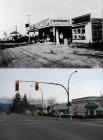1
Map - Buildings Through Time exhibit - Floor Mural2005
Pitt Meadows, BC, Canada
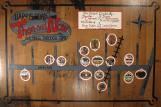 Credits:
Credits:Created by Jennifer Chernecki Joanna Karczmarek and Karen Dykes
2
Harris RoadPitt Meadows' main street is named after Wellington Jeffers Harris, the first Reeve of Maple Ridge, who arrived in Pitt Meadows in the 1870's with his wife, Mary Jane, and his son, Frank. W.J. Harris was also a dyking commissioner and, later, a member of the British Columbia Legislature. Mary Jane Harris was one of the first women of European descent to arrive in the area. She helped to establish the first Sunday School in the area and acted as a mid wife before the arrival of a doctor to the community. She was a founding member of the Pitt Meadows Women's Institute and ran a successful family based cheese making business. Frank Harris served as a municipal councilor as well as an acting Reeve. He also served for many years as the secretary of the Pitt Meadows School Board.
Before the Lougheed Highway was pushed through Pitt Meadows, Harris Road served as the link between the Dewdney Trunk Road/Hammond Road east west route from Pitt Meadows to Maple Ridge. In the early years very little development was found along the corridor. At the time of the municipality's incorporation in 1914 Harris Road was lined primarily with farms, forest and bushland. The only commercial building was the General Store and Post Office that sat beside the C.P.R. tracks, and at the far end of the Road was the Number One School House. Hazel Anderson (nee: Park), a pioneer resident, who was born the same year the municipality incorporated, remembers walking to school along Harris Road in the early 1920's. In 1994, when recording her memories of going to school in Pitt Meadows, she wrote:
"Sometimes when my sister and I walked up Harris Road in the early morning it looked a long lonesome road and often [we] never met anyone. There was lots of bush and very few homes. Our only fear was meeting a bear but [we] never did see one". (Hazel Anderson, 1994)
Harris Road was first paved in the 1940's and in 1977 was widened to four lanes, repaved and a sidewalk added. Today it is still the main route into and out of most areas of the central part of Pitt Meadows. It is heavily used and is lined with condominiums, shopping malls and a mix of other retail and commercial spaces. In amongst these buildings are the 15 sites and structures documented in the Pitt Meadows Museum & Archives "Buildings Through Time: Harris Road Then and Now" exhibit, many of which owe their continued existance to the evolution of their use and to the commitment of a community to the preservation, when possible, of its important heritage sites.
Lougheed Highway
Completed through Pitt Meadows in the very early 1930's, the Lougheed Highway replaced the Dewney Trunk to Harris to Hammond Road route to Maple Ridge. Originally a two lane dirt road, traffic in the early years was sparse. One pioneer resident who lived in a house beside the Highway recalled (in an oral history 1980 c.) that she only saw a handful of vehicles on the road each day. Today the Lougheed is a four lane highway and the farmland that once bordered it is quickly giving way to commercial and residential developments.
Advent Road
Advent Road is named after the Seventh Day Adventists who prior to the 1920's had a strong presence in Pitt Meadows. In her 1967 book "Through a Century of Progress: the Historical Story of Pitt Meadows" Edith McDermott researched and wrote the following about the Adventists' time in Pitt Meadows:
"..They had their settlement on the north west portion of the Ford Road as far as what is now McTavish Road, their property extending along the Harris Road and down what is now the Advent Road. William Manson, who in 1893 was one of the commissioners for the Maple Ridge Dyking District, and later became an M.P., donated both land and money to the Adventist cause. They built the Manson Industrial Academy, a building containing 16 rooms, which was reached by a high board walk going in from the Ford Road. The building was in as far as what is now the Advent Road."
She also found the following information in an excerpt from the report to the Western Canadian Union Conference of the Seventh-Day Adventist Church 1910:
"Manson Industrial Academy. At Pitt Meadows, a little town 24 miles east of Vancouver, we have an academy for the education and training of our young people. The main building in size is 42 feet by 50 feet with three stories above the basement, and is capable of accommodating 25 students with board and room. This building was erected at a cost of about $6000 and has now been in use a little over one year. This is the development from the first effort made in a log school house about six years ago. The total enrolment is 35. Professor K. R. Hughey is the principal, and has the assistance of three teachers. Connected with the school is about 187 acres of land, a part of which will be sold, as necessity demands. The school is doing nicely through the efforts of the present faculty and we believe it will succeed in its important mission of training for young men and women."
As a foot note she added:
"By the close of the great war, many of the families had moved away. The Academy was closed and deserted. About 1920 it was purchased and torn down by a man named Aikenhead. He sold the lumber, doors and windows, in fact anything that was saleable. Thus ended the Academy." (Edith McDermott, "Through a Century of Progress, the Historical Story of Pitt Meadows", 1967)
For many decades after the Adventists had left Pitt Meadows Advent Road was lined with farmland, most notable of which was the Howe family dairy farm. On the north side closer to Harris Road was the Japanese Canadian Hall which was built in 1939.
Today Advent Road, which runs west from Harris Road, forms the main street in the Highland Park area of Pitt Meadows. All evidence of the Seventh Day Adventists is gone. Also gone is the farmland, replaced with houses and an elementary school. The building that was the Japanese Canadian Hall remains and is now a church. However, as the cost of land for housing in the Greater Vancouver area rises there is the worry that this building will also be gone in the not too distant future.
Ford Road
Named for Sherman Herbert Ford, a potato farmer and land owner who arrived in Pitt Meadows about 1910. Ford was the community's Reeve in 1932/1933. As the Road headed west it was laid over peat bogs and, therefore, for many years was an elevated, single lane path constructed of wood. The Road, now paved, winds through much of Pitt Meadows' farm land.
Hammond Road
Named after John and William Hammond who pre-empted the land that became the townsite that bears their name, Hammond. Hammond Road connected Pitt Meadows to Hammond and formed part of the early east west route that connected Pitt Meadows to Hammond and Maple Ridge prior to the Lougheed Highway.
3
Number One School House - Buildings Through Time exhibit - Floor Mural2005
Pitt Meadows, BC, Canada
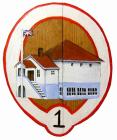 Credits:
Credits:Mural created by Jennifer Chernecki, Karen Dykes, and Joanna Karczmarek
Graphic by Jennifer Chernecki
4
Number One School Site1909 - 1953 and 2007
Pitt Meadows, BC, Canada
 Credits:
Credits:Bottom image photographed by Joanna Karczmarek, before and after graphic by Joanna Karczmarek
5
Pitt Meadows Number One School SiteGone from this property for more than fifty years, Pitt Meadows' first school house, the Number One School Pitt Meadows, opened here in September, 1909, five years before the municipality incorporated. It was a one room building and sat on property donated by William R. McMyn, an early settler and farmer. In 1994 a former student of the school, Hazel Anderson, wrote of her early memories of the school as follows:
"There was no electricity, running water or inside plumbing, just outhouses. There was a big hand pump on a well outside and a tin cup hung on it for all to use. At the back of the school room was a big wood burning stove that the teacher had to keep burning during the cold weather. Those that sat near it were too hot and up front were cold. There was a small entrance hall with the boys' coat closet on one side and the girls' on the other. There were five rows of desks; three were double desks and two rows single. I had to sit with a boy in a double desk so really got teased by the rest of the class… We all carried our lunch in little lard or syrup pails and I guess there was good plain food in them as there was no ice cream, pop, potato chips, etc.". (Hazel Anderson, 1994)
Just prior to the First World War a second one room school was built at the corner of Harris and McNeil Roads in the northern area of Pitt Meadows. It was officially the Number Two School Pitt Meadows but was more commonly known as the Richardson School. In the 1930's the Superior School System was adopted in Pitt Meadows giving one principal responsibility over both of these schools as well as three additional buildings. During the same decade a second building was constructed on the Number One School site to house the senior elementary grades. High school students continued to attend classes in Maple Ridge. Also around this time the basement of the Number One School was turned into a manual training shop. Up until 1945 Pitt Meadows had its own school district and trustees, but became part of School District 42 in 1945.
In 1953 the five rooms Pitt Meadows Elementary School opened. The Number One school was intended to be used as overflow classrooms but mysteriously burned prior to the beginning of the school year. Pitt Meadows Elementary is now the oldest of the four elementary schools currently in service in Pitt Meadows. Pitt Meadows Secondary School opened in 1961.
Much of the Number One school site is now Lion's Park. Nothing remains of the school site but the park, with an abundance of playground equipment, is still a space for children.
6
Cook House - Buildings Through Time Exhibit - Floor Mural2005
Pitt Meadows, BC, Canada
 Credits:
Credits:Mural created by Jennifer Chernecki, Karen Dykes, and Joanna Karczmarek
Graphic by Jennifer Chernecki
7
Edward and Annie Louise Cook HouseCirca 1914 and 2007
Pitt Meadows, BC, Canada
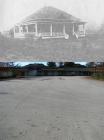 Credits:
Credits:Bottom image photographed by Joanna Karczmarek, before and after graphic by Joanna Karczmarek
8
A Tale of Two HousesOver the last 30 years the District - now City - of Pitt Meadows has, on a number of occasions, purchased properties that are valuable heritage resources, and has had to make the often difficult decision on whether to retain or demolish the buildings. Foremost among these properties is the Old General Store building. Happily, there was no question as to the fate of this building after its purchase as it was to become the home of the Pitt Meadows Museum. This is the tale of two other structures.
The Cook House: Expropriation and Demolition
The porch column and post box found in the "Buildings Through Time: Harris Road then and Now" exhibit are two of only a handful of objects that are left from the once stately residence of the Edward Cook family.
Edward Cook arrived in Pitt Meadows in 1877 and took on a crown grant of 72 acres of land located on Ford Road between Harris and Baynes Roads. Within a few years his new bride, Annie Louise Cook, the "first bride ever brought home to Pitt Meadows", arrived by sternwheeler, disembarking at Bonson's Landing early in July on a day when the mosquitoes were so thick "the sun was blacked out". In 1914 the couple built their dream house on the property. The single level structure was considered a landmark on Harris Road and its lawns were known throughout the community for croquet and other lawn games played thereon. In the early 1980's Edith Lilly, the Cook's granddaughter wrote about the property:
"About 1916 or 1917 they built a lovely new house about 100 feet off Harris Road with nice lawns and equipped with several lawn games. They had also cleared many acres of land by then and all were planted with strawberries which grew so well on their land". (Edith Lillly - Cook granddaughter, circa 1980)
After the deaths of Edward and Annie Louise Cook the property came into the possession of their sons. While the other brothers sold off their lots early, Harry Cook, who had the section of the property with the house, held on to his until1976 when the municipality expropriated the property for the purpose of developing a new municipal hall site. Harry was given permission to continue to occupy the property for a few years after the expropriation but the day finally came when he had to be removed from the site. On that day, it is said, Harry, who was in his early 80's, sat in a chair on the beautiful wrap around porch and greeted the men from the municipality with a shot gun. No shots were taken, the municipality prevailed and Harry Cook was moved out of the house which stood empty for some time and was eventually demolished. The beautiful lawns were replaced many years ago with a parking lot and strip mall. Today the mall is gone and new housing is going in. Harry Cook passed away in 1985 at the age of 89. Saddened about the loss of his home, he once stated to a local newspaper "we had a crown land deed which nobody can take away but the Queen, but they did and they did it under false pretenses".
9
Pitt Meadows Community Church - Buildings Through Time Exhibit - Floor Mural2005
Pitt Meadows, BC, Canada
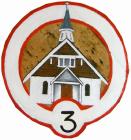 Credits:
Credits:Mural created by Jennifer Chernecki, Karen Dykes, and Joanna Karczmarek
Graphic by Jennifer Chernecki
10
Pitt Meadows Community Church1958 and 2007
Pitt Meadows, BC, Canada
 Credits:
Credits:Bottom image photographed by Joanna Karczmarek, before and after graphic by Joanna Karczmarek
11
The Pitt Meadows Community ChurchThe little white church located at the corner of Harris and Ford Roads was originally built by the Seventh Day Adventists who at one time had a large presence in the community. The building dates to 1910 and is an example of an early B.C. Mills prefabricated structure, purchased through a catalogue and shipped in pieces to the purchaser ready for assembly.
In 1922 the Adventists sold the building to the Community Church Society for $1,000.00. Prior to the sale the Protestant denominations in the community had met in the basement of the Number One School building at the corner of Hammond and Harris Roads.
In a newspaper interview done in 1982 one member of the Church had memories of early church days that included "a small fence which used to circle the church, a wood shed out back which people tied their horses to, of course an outdoor toilet, and an old pot stove in the back of the church". She recalled "those in the back of the church were always nice and warm but those in the front nearly froze in the winter months". She also recalled that the bell tower atop the Church had never held a bell. The church hall just to the north of the building was built in the 1950's to provide a place for Sunday School classes and Church functions.
The Community Church was endowed with Municipal Heritage Status in 2002 and in 2003 the Community Church Society embarked on a major renovation of the building including a new foundation, new roof and other structural repairs, allowing this little wooden building to remain in continuous use for almost 100 years, all of them as a Church.
12
Davie Jones Market - Buildings Through Time Exhibit - Floor Mural2005
Pitt Meadows, BC, Canada
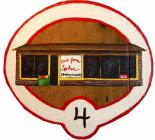 Credits:
Credits:Mural created by Jennifer Chernecki, Karen Dykes, and Joanna Karczmarek
Graphic by Jennifer Chernecki
14
Davie Jones' StoreDavie Jones arrived in Pitt Meadows in 1944, having purchased William Orcutt's business with the intention of running a small general store - Davie Jones' Confectionary, which would later be known as Davie Jones' Locker. He owned the store for over 30 years, finally retiring in 1975. However, in the last few years of ownership he relinquished management to his nephew who brought in a new look and name - Davie Jones' Market - to the business.
During the 1950's an integral part of the business was the soda fountain where people, particularly children, gathered to socialize. In 2004 one of Davie Jones' granddaughters fondly remembered:
"What I really liked when I was younger was the soda fountain. I got to make sodas, floats, milkshakes and ice cream cones. I was a kid so I always made good 'kid size' cones with the ice cream leaning over the sides. We had tea in china tea pots and fancy tea cups. My grandmother would make sandwiches and sometimes sweet cakes. I had a high stool of my own on the other side, and if my grandfather was doing the talking and visiting with locals, I would always pull up a wooden pop crate and sit there very quietly and listen. Originally there were about six high stools around a high counter on the right as [you] came in the store. It was a soda fountain just like other places had in the 50's but the stools were high, made from real green leather and they had backs on them that you could lean back [on] when you sat and they swiveled".
Eventually the business sold again, the building demolished and the present structures were erected on the site.
In 1952 Davie Jones was elected to the Maple Ridge School Board as Pitt Meadows' representative. He remained on the Board for 14 years, five of them as Chair. In 1978, in order to pay tribute to his many years of service to the school district and the community, Pitt Meadows' third elementary school was named in his honour.
